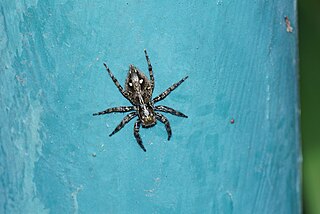
Thyenula is a genus of African jumping spiders that was first described by Eugène Louis Simon in 1902.

Euophryini is a tribe of jumping spiders. It has also been treated as the subfamily Euophryinae.

Wanda Wesołowska is a Polish zoologist known for her work with jumping spiders. She has described more species of jumping spider than any contemporary writer, and is second only to Eugène Simon in the history of arachnology. Originally a student of ornithology, she developed an interest in jumping spiders while still a student at the Siedlce University of Natural Sciences and Humanities in the 1970s.
Chinophrys is a genus of jumping spiders that was first described by J. X. Zhang & Wayne Paul Maddison in 2012.
Foliabitus is a genus of Asian jumping spiders that was first described by J. X. Zhang & Wayne Paul Maddison in 2012. As of June 2019 it contains only two species, found only in Asia: F. longzhou and F. scutigerus.
Parabathippus is a genus of Southeast Asian jumping spiders that was first described by J. X. Zhang & Wayne Paul Maddison in 2012.
Parvattus is a monotypic genus of Chinese jumping spiders containing the single species, Parvattus zhui. It was first described by J. X. Zhang & Wayne Paul Maddison in 2012, and is only found in China.
Thyenula cheliceroides is a jumping spider species in the genus Thyenula that lives in South Africa.
Thyenula clarosignata is a jumping spider species in the genus Thyenula that lives in South Africa.
Thyenula dentatidens is a jumping spider species in the genus Thyenula that lives in South Africa. Only the male has been described.
Thyenula haddadi is a jumping spider species in the genus Thyenula that lives in South Africa.
Thyenula montana is a jumping spider species in the genus Thyenula that lives in South Africa.
Thyenula rufa is a species of jumping spider in the genus Thyenula that lives in South Africa. It was first described in 2014.
Thyenula tenebrica is a jumping spider species in the genus Thyenula that lives in South Africa. Only the female has been described.
Thyenula virgulata is a jumping spider species in the genus Thyenula that lives in South Africa. The male was first described in 2014.
Thyenula vulnifica is a jumping spider species in the genus Thyenula that lives in South Africa.
Thyenula sempiterna is a jumping spider species in the genus Thyenula that lives in Zimbabwe and South Africa. The female was first described in 2000 and the male in 2014.

Pseudicius wesolowskae is a species of jumping spider in the genus Pseudicius that lives in Hebei, China. The spider was first described in 2001 by Mingsheng Zhu and Daxiang Song. The spider is small, with a body length that is between 3.43 and 3.78 mm. The male is larger than the female. The spider has a light brown carapace with a black eye field. The abdomen is a dark brown on the top, marked by a pattern of white spots, and grey-yellow underneath, with a pattern of yellow-white spots. The copulatory organs enable the species to be distinguished from others in the genus. The male has a long embolus and unusual tibial apophyses. The female has a cross-shaped marking towards the rear of its epigyne. The species is named after the Polish arachnologist Wanda Wesołowska.

Plexippus wesolowskae is a species of jumping spider in the genus Plexippus that lives in Bangladesh. It was first described in 1998 by V. Biswas and D. Raychaudhuri. The spider is medium-sized, with a carapace 3.4 mm (0.13 in) and an abdomen 3.2 mm (0.13 in) long. The carapace is dark brown with a black band and white cross. The abdomen is a lighter brown with one white and two black stripes. It is similar to the related Plexippus paykulli that can also be found in the same country, but can be distinguished by features like the elongated almost vase-like shape of the sternum and lack of tibial apophysis on the palpal bulb.

Pancorius wesolowskae is a species of jumping spider in the genus Pancorius that lives in China. The species was first described in 2020 by Wei-Hang Wang and Cheng Wang. The spider is large, measuring between 6.3 and 7.93 mm in overall length. The carapace is dark brown and the opisthosoma dark grey with a pattern of light and dark. The female is larger than the male but otherwise very similar in colouration. The female spider is similar to Pancorius wangdicus but differs in have slit-shaped copulatory openings compared to the other species. The male has a blunter and shorter retrolateral tibial apophysis than the related Pancorius cadus.





